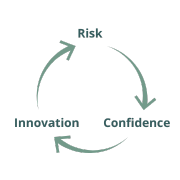If innovation is return, impacto, income… why don´t we innovate more?
During the time I´ve been working on innovation and, in my case, boosting the use of technologies by entities through the transfer process, I´ve been able to speak and see examples of why do we find difficult to innovate.
We find it difficult because we struggle to dedicate time, resources and energy to planning what to innovate in, because we find it hard to accept that competition is growing because it has made innovation its main strategy.
Because we find it hard to propose new ways of doing things, new projects, new ideas to our superiors, because it’s easier to stick with what we’ve always done and not get involved in “other issues.”
Because it´s hard for us to leave that comfort zone, of that acquired routine that, although it no longer challenges us, offers us security in achieving results.
We struggle because innovation means venturing into uncertainty, and that scares us. We fear error, the possibility of failure, the idea that the resources we put in may not yield the expected results.
We struggle because the unknown is frightening, and even more so when achieving it requires overcoming certain barriers and facing risks that, although sometimes known, we don’t always understand how to manage.
It´s also difficult for us because innovation requires a change in mindset. It’s not just about investing in new technologies or products; it’s about transforming our way of thinking, questioning what we take for granted.
We struggle because we often prefer what we know, even if it means remaining stagnant.
And yet, the truth is that the real risk isn’t in innovating, but in not doing so. The real danger lies in looking to the future and realizing that we’ve been surpassed by those who dared to change.
For all these reasons, the key to innovation is understanding and, above all, accepting that risk is part of the process. This way, you can identify how risk affects you and establish the conditions to mitigate it.
“The key to innovation is understanding and, above all, accepting that risk is part of the process.”
How to manage risk in innovation
A risk management system inherent to the innovation process is the first step toward unlocking this fear of innovation. This isn’t just a theoretical process, but rather a matter of implementing certain concrete actions that create an ideal environment to stimulate innovation.
In my experience, the factors that are crucial for creating a good risk mitigation system are:
- Create your own innovation ecosystem and surround yourself with strategic partners: technology centers, universities, startups, client or supplier companies to promote the transfer of know-how from these entities and accelerate collective learning, thus reducing the time to impact.
- Planning innovation budgets: allocating specific resources to innovative projects within a specific timeframe, avoiding innovation depending on improvisation or success associated with competitive competition. Resources should not be allocated that jeopardize the organization’s core business, but sufficient resources should act as a driving force. One percent of a year’s budget is already a lot. It’s important because just as what isn’t on the agenda isn’t a priority, what isn’t budgeted doesn’t exist.
- Leadership drive: Firm commitment from the top is the engine that gives legitimacy and continuity to innovation and allows the ecosystem you’ve chosen to endure over time and achieve results. This commitment is reflected in actions, not only budgetary but also through participation in meetings on new initiatives or in ecosystem analysis and selection.
- Implement innovative routines: Incorporate practices that make innovation a constant. Innovation isn’t a one-time or improvised effort. It’s about encouraging trial and error and fostering ideation, the generation of new proposals for change, and an entrepreneurial spirit among teams. It’s about creating an innovative culture that permeates the organization horizontally.

- Adapted profitability indicators: Designing specific metrics that realistically measure innovation, considering technological and market maturity and its potential impact and scalability. This means moving away from traditional economic indicators, which are adequately designed for investment projects or continuous improvement projects in general, but are ill-equipped to measure the results or profitability of risky projects that require much broader and more flexible ranges and that require accepting the need to abandon a project at a certain point.
All of this pursues a very clear objective: to build CONFIDENCE in the process, because if risk is a constant in innovation, trust is the constant that balances it.

Trust is like the lifeblood of innovation processes because it’s what we don’t see, but it connects all the elements that make innovation possible and, above all, helps mitigate risk. Trust connects people’s courage to propose ideas, management’s vision to drive them forward, and relationships with your ecosystem. It helps you acknowledge and accept that mistakes are part of learning and the innovation process.
Ultimately, the key is that innovation doesn’t progress solely through technology or resources; it progresses through the people who drive it and, above all, through the shared trust between them. This trust is what turns risk into opportunity and allows us to bring the future into the present.
Innovate for you, innovate for me, innovate for us.
- How to overcome the fear of innovation: confidence and risk management - 19 September 2025
- Skylines and roots: Dubai and its innovation strategy - 20 June 2025
- Innovate shouldn´t be like untangling a daisy - 11 April 2025
